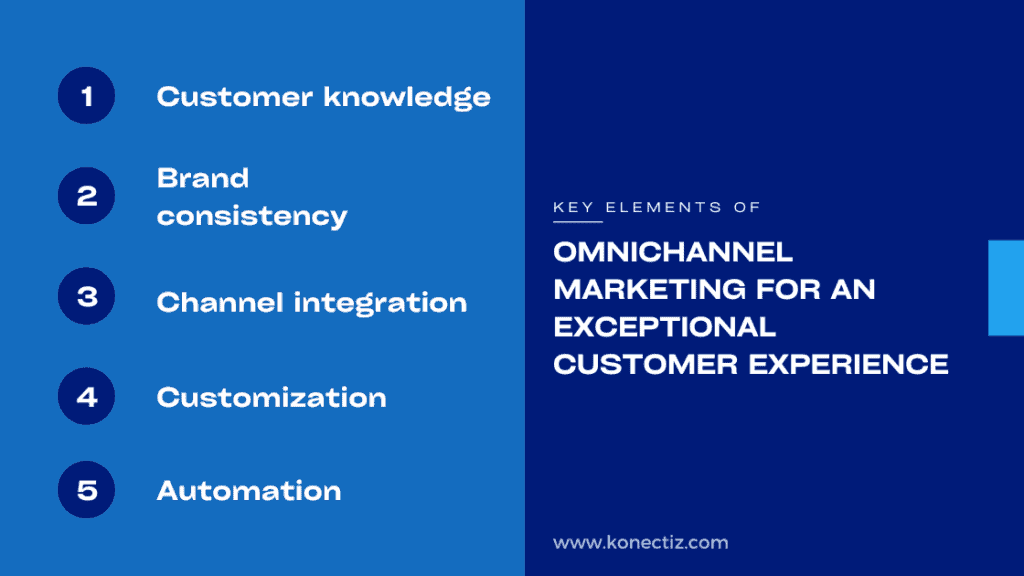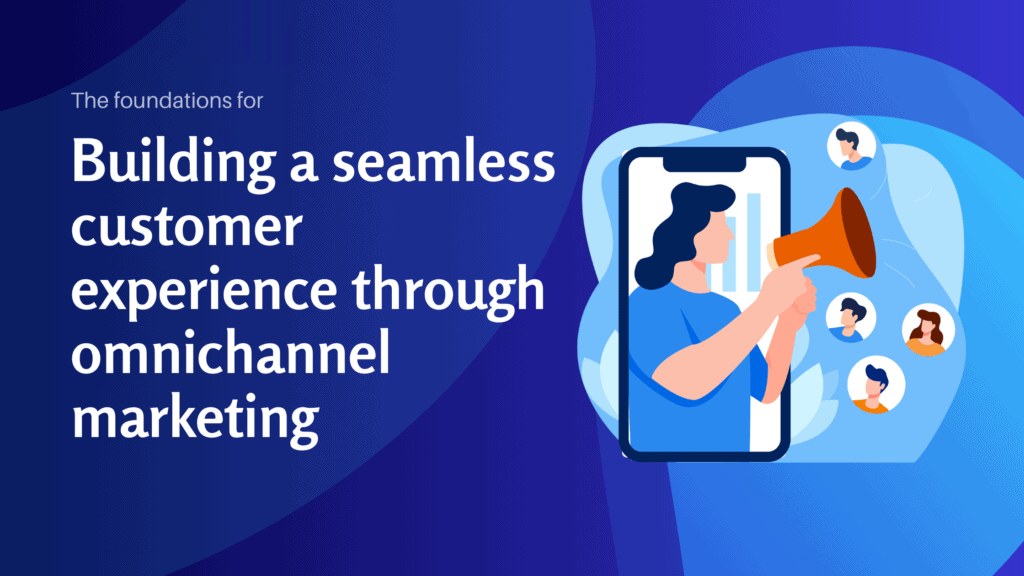Introduction
Creating a seamless customer experience is essential for businesses in today’s digital landscape. Omnichannelity, based on a strategic approach aimed at delivering a seamless experience across all communication channels, is the key to achieving this goal. This approach enables companies to interact with their customers in a consistent and personalized way, whether online, in-store or via social networks.
Omnichannel offers many benefits to businesses, including increased customer satisfaction and loyalty, as well as higher sales. By using a combination of online advertising, targeted email, social networking and in-store experiences, companies are able to provide a smooth customer journey and deliver superior service. In this article, we’ll look at the steps you need to take to create an effective omnichannel customer experience.
Understanding omnichannel marketing
Omnichannel marketing is a strategy that aims to deliver a seamless, consistent customer experience across all available communication channels and touchpoints, be they online, offline or mobile interactions. This approach integrates different channels such as social networks, websites, physical stores and mobile applications, enabling customers to move seamlessly from one channel to another. The aim is to create a holistic experience where every interaction contributes to strengthening the relationship between brand and customer.
By understanding customer behaviors and preferences across different channels, companies can personalize their marketing strategies and offer more relevant and engaging interactions, promoting loyalty and customer satisfaction.
Key elements of omnichannel marketing for an exceptional customer experience

Omnichannel marketing relies on several key elements to create a seamless customer experience. Here are some of the most important things to consider:
1. Customer knowledge
To offer your customers a personalized experience, you need to know them inside out. This means collecting and analyzing data on their preferences, buying behavior and past interactions with your company. The more you know about your customers, the more you can personalize your marketing and service.
2. Brand consistency
Your brand must be consistent across all communication channels. This includes using a consistent visual identity, a coherent tone of voice and consistent messages. When your customers interact with your brand, whether online or offline, they need to recognize your identity and style immediately.
3. Channel integration
Channel integration is key to creating a seamless customer experience. This means that all communication channels need to be connected and interact with each other. For example, if a customer adds a product to their shopping cart on your website, they need to be able to find that product in their cart when they connect to your mobile application.
4. Customization
Personalization is one of the key benefits of omnichannel marketing. By using the data you’ve collected on your customers, you can personalize your marketing to meet their specific needs and preferences. This may include sending personalized e-mails, recommending products based on purchase history, or displaying targeted advertising on social networks.
5. Automation
Automation plays a key role in omnichannel marketing. By automating certain tasks, such as sending follow-up e-mails or managing social media, you can free up time and resources to concentrate on more strategic tasks. Automation also enables you to deliver a consistent, real-time experience to your customers.
The importance of a consistent customer experience
The importance of a seamless customer experience lies in its ability to strengthen customer loyalty and satisfaction, while increasing their lifetime value to the company. By offering a consistent, seamless experience across all touchpoints, whether online, offline or mobile, companies can build a strong relationship with their customers. This translates into increased customer retention, positive word-of-mouth and better customer value.
Before starting to implement an omnichannel strategy, it’s essential to understand the customer journey. A customer journey map is a visual tool that represents the different stages your customer goes through, from awareness to purchase and beyond. By understanding the different stages and potential contact points, you can identify opportunities for interaction and personalization.
Creating a customer journey map involves collecting data on your customers’ past interactions with your company. This may include data on visits to your website, previous purchases, interactions on social networks, phone calls, etc. The more data you have, the more accurate and useful your customer journey map will be.
Key components of omnichannel marketing
The key components of omnichannel marketing include several essential elements that work together to create a seamless, fluid customer experience. Here are some of these components:
Key elements of omnichannel marketing for an exceptional customer experience
1. Channel integration
Channel integration is fundamental to omnichannel marketing. It involves connecting and coordinating all the contact points used by customers, whether physical stores, websites, mobile applications, social networks or other channels. The aim is to provide a seamless, consistent experience across all these channels, enabling customers to move easily from one to another without interruption.
2. Customization
Personalization is a crucial aspect of omnichannel marketing. By using customer data collected from various channels, companies can offer individualized, relevant experiences to each customer. This may include product recommendations based on previous purchasing preferences, special offers tailored to the customer’s specific needs, or personalized communications based on past behavior.
3. Automation
Automation plays a key role in omnichannel marketing, enabling companies to manage customer interactions efficiently and consistently across different channels. Automated processes can be used to send follow-up e-mails, push notifications on mobile applications, messages on social networks, and much more. This enables companies to interact with customers in a timely and relevant way, even on a large scale.
4. Data analysis
Data analysis is essential for measuring and optimizing omnichannel marketing performance. By tracking and analyzing customer interactions across different channels, companies can gain valuable insights into customer behavior and preferences. This enables them to understand what’s working well and what can be improved, and adjust their strategy accordingly to maximize the impact of their marketing efforts.
Creation of a customer journey map
Creating a customer journey map is an essential step in implementing an effective omnichannel marketing strategy. This visual map represents the different stages customers go through when interacting with your company, from awareness to purchase and beyond.
Key steps in creating a customer journey map
Here are the key steps for creating a customer journey map:
1. Data collection
The first step is to collect data on customers’ past interactions with your company. This may include data on visits to your website, previous purchases, interactions on social networks, telephone calls, and any other relevant points of contact. The more data you have, the more accurate and useful your customer journey map will be.
2. Identifying the steps
Once you’ve collected the necessary data, you can start tracing the customer journey. Identify the different stages that customers go through, such as awareness, product research, the buying decision, the actual purchase, and after-sales follow-up. Each company will have its own specific steps, depending on its nature and sector of activity.
3. Contact point mapping
For each stage of the customer journey, identify the potential contact points that customers may encounter. This may include online interactions, such as visiting the website, reading e-mails or browsing social networks, as well as offline interactions, such as visiting a store or contacting customer service.
4. Customization and integration
Once you’ve identified the stages and touchpoints, you can start personalizing and integrating the customer experience across all these channels. Identify times when personalized interaction would be appropriate, and opportunities to synchronize customer information across channels to deliver a seamless experience.
Integrate multiple channels for a seamless experience
Integrating multiple channels to deliver a seamless experience is an essential practice in omnichannel marketing. This enables companies to deliver a seamless, consistent customer experience, whatever channel customers choose to interact via.
Some strategies for effectively integrating multiple channels :
1. Brand consistency
Make sure your brand is recognizable and consistent across all channels. This includes the use of a consistent visual identity, a uniform tone of voice and coherent messages. When customers interact with your company, whether online, in-store or on social networks, they need to recognize your identity and style immediately.
2. Customer data synchronization
To deliver a seamless experience, it’s crucial to synchronize customer information across channels. This means that customer data, such as preferences, purchase history and past interactions, must be accessible and updated in real time across all channels. This enables customers to move from one channel to another without losing data or information.
3. Fluid communication
Facilitate cross-channel communication by offering customers multiple contact options and ensuring a rapid, consistent response across all channels. For example, if a customer starts a conversation on social networks and then decides to make a phone call, make sure the conversation history is available to the customer service representative.
4. Delivering a seamless experience
Create smooth, frictionless customer journeys by eliminating potential barriers between channels. For example, make sure that customers can easily move from one channel to another without having to repeat information already provided. In addition, use technologies such as real-time tracking and notifications to inform customers of the status of their orders or service requests.
Leverage data and analysis for better customer knowledge
Harnessing data and analysis is essential for acquiring a better understanding of the customer as part of omnichannel marketing. Here’s how companies can use this approach to improve their understanding of customers:
1. Complete data collection
To start with, companies need to collect comprehensive customer data from a variety of touchpoints, including online and offline interactions. This can include demographic data, purchase histories, social network interactions, website browsing behavior, responses to marketing emails, etc.
2. Data consolidation
Once data has been collected, it’s crucial to consolidate it into a single, centralized data source. This gives companies a complete overview of each customer, combining information from different sources and channels.
3. Data analysis
Once the data has been consolidated, companies can analyze it to extract meaningful insights into customer behavior, preferences and needs. Data analysis can reveal hidden trends and patterns, enabling companies to better understand what motivates their customers and how they interact with the brand.
4. Audience segmentation
Based on insights gained from data analysis, companies can segment their audience into homogeneous groups with similar characteristics and behaviors. This makes it possible to personalize messages and offers for each segment in a more precise and relevant way.
5. Personalized interactions
Using insights gained from data analysis, companies can personalize customer interactions across all channels. This can include personalized product recommendations, special offers based on customer preferences, targeted marketing communications, and so on.
Tools and technologies for implementing omnichannel marketing
The successful implementation of omnichannel marketing relies heavily on the use of appropriate tools and technologies.
Some of the essential tools and technologies to help companies effectively manage their omnichannel campaigns:
1. Customer relationship management (CRM) platforms
CRMs are indispensable tools for centralizing and managing customer data. They enable companies to store information about customers, such as contact details, purchase history, previous interactions with the brand, and so on. CRM also facilitates customer segmentation and personalized communications.
Examples of popular CRM tools include Salesforce, HubSpot CRM and Zoho CRM. These platforms offer a full range of functionalities for managing sales, customer service and marketing, enabling companies to better understand and serve their customers.
2. Marketing automation platforms
Marketing automation platforms enable companies to plan, execute and track their marketing campaigns across different channels. They offer features such as e-mail automation, social media management, performance tracking and data analysis.
Examples of popular marketing automation tools include HubSpot, Marketo and Mailchimp. These platforms offer advanced features to automate marketing processes and improve campaign efficiency.
3. Analysis and business intelligence tools
Analysis and business intelligence tools are essential for understanding the performance of omnichannel marketing campaigns. They enable companies to track and analyze customer interactions across different channels, measure campaign effectiveness and identify opportunities for improvement.
Examples of analytics and business intelligence tools include Google Analytics, Adobe Analytics and Tableau. These tools offer advanced functionalities for visualizing and analyzing marketing data, enabling you to make strategic decisions based on precise insights.
4.social network management platforms
Social networks play a crucial role in omnichannel marketing, and social network management platforms help companies to effectively manage their presence on these channels.
These tools allow you to plan and publish content, monitor conversations, respond to comments and messages, and measure user engagement. Examples of social network management platforms include Hootsuite, Buffer and Sprout Social. These tools offer advanced features for managing and optimizing a company’s presence on social networks.
5. Integrated e-commerce solutions
For companies operating in e-commerce, it’s essential to have an integrated e-commerce platform that can be connected to other sales channels. These solutions enable companies to easily manage inventory, process orders and payments, and synchronize customer data between different sales channels. Examples of integrated e-commerce solutions include Shopify, Magento and WooCommerce.
These platforms offer advanced functionalities for creating and managing online stores efficiently, while integrating customer data with other sales channels.
Conclusion
The future of omnichannel marketing is bright, with many exciting opportunities for companies of all sizes and in all sectors. As consumers continue to adopt new channels and technologies to interact with brands, omnichannel marketing becomes increasingly essential to remain competitive in the marketplace.





